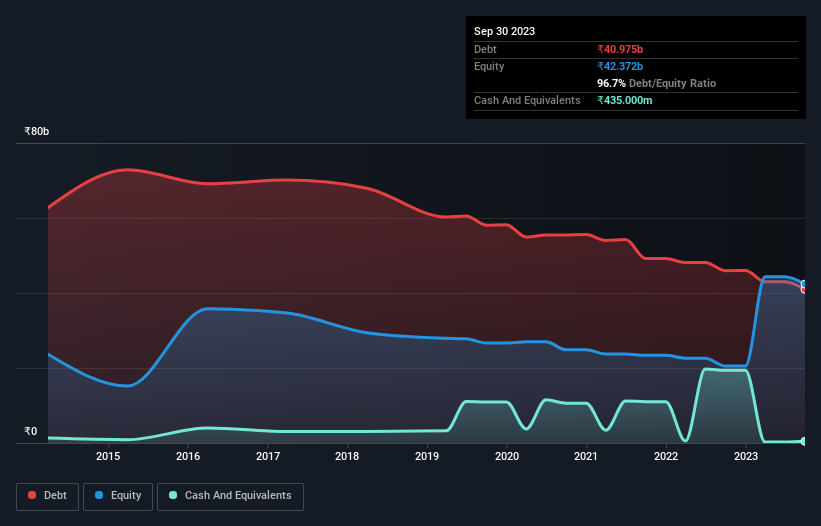Is Bajaj Hindusthan Sugar (NSE:BAJAJHIND) A Risky Investment?

Legendary fund manager Li Lu (who Charlie Munger backed) once said, 'The biggest investment risk is not the volatility of prices, but whether you will suffer a permanent loss of capital.' When we think about how risky a company is, we always like to look at its use of debt, since debt overload can lead to ruin. Importantly, Bajaj Hindusthan Sugar Limited (NSE:BAJAJHIND) does carry debt. But the real question is whether this debt is making the company risky.
When Is Debt Dangerous?
Generally speaking, debt only becomes a real problem when a company can't easily pay it off, either by raising capital or with its own cash flow. Ultimately, if the company can't fulfill its legal obligations to repay debt, shareholders could walk away with nothing. However, a more common (but still painful) scenario is that it has to raise new equity capital at a low price, thus permanently diluting shareholders. Of course, the upside of debt is that it often represents cheap capital, especially when it replaces dilution in a company with the ability to reinvest at high rates of return. The first step when considering a company's debt levels is to consider its cash and debt together.
View our latest analysis for Bajaj Hindusthan Sugar
How Much Debt Does Bajaj Hindusthan Sugar Carry?
As you can see below, Bajaj Hindusthan Sugar had ₹41.0b of debt at September 2023, down from ₹46.0b a year prior. And it doesn't have much cash, so its net debt is about the same.

How Healthy Is Bajaj Hindusthan Sugar's Balance Sheet?
We can see from the most recent balance sheet that Bajaj Hindusthan Sugar had liabilities of ₹47.8b falling due within a year, and liabilities of ₹49.7b due beyond that. Offsetting this, it had ₹435.0m in cash and ₹943.7m in receivables that were due within 12 months. So its liabilities total ₹96.1b more than the combination of its cash and short-term receivables.
This deficit casts a shadow over the ₹33.5b company, like a colossus towering over mere mortals. So we'd watch its balance sheet closely, without a doubt. At the end of the day, Bajaj Hindusthan Sugar would probably need a major re-capitalization if its creditors were to demand repayment.
We use two main ratios to inform us about debt levels relative to earnings. The first is net debt divided by earnings before interest, tax, depreciation, and amortization (EBITDA), while the second is how many times its earnings before interest and tax (EBIT) covers its interest expense (or its interest cover, for short). Thus we consider debt relative to earnings both with and without depreciation and amortization expenses.
Weak interest cover of 0.28 times and a disturbingly high net debt to EBITDA ratio of 14.6 hit our confidence in Bajaj Hindusthan Sugar like a one-two punch to the gut. The debt burden here is substantial. One redeeming factor for Bajaj Hindusthan Sugar is that it turned last year's EBIT loss into a gain of ₹632m, over the last twelve months. The balance sheet is clearly the area to focus on when you are analysing debt. But it is Bajaj Hindusthan Sugar's earnings that will influence how the balance sheet holds up in the future. So when considering debt, it's definitely worth looking at the earnings trend. Click here for an interactive snapshot.
Finally, a company can only pay off debt with cold hard cash, not accounting profits. So it is important to check how much of its earnings before interest and tax (EBIT) converts to actual free cash flow. Over the last year, Bajaj Hindusthan Sugar actually produced more free cash flow than EBIT. That sort of strong cash conversion gets us as excited as the crowd when the beat drops at a Daft Punk concert.
Our View
To be frank both Bajaj Hindusthan Sugar's interest cover and its track record of staying on top of its total liabilities make us rather uncomfortable with its debt levels. But on the bright side, its conversion of EBIT to free cash flow is a good sign, and makes us more optimistic. We're quite clear that we consider Bajaj Hindusthan Sugar to be really rather risky, as a result of its balance sheet health. For this reason we're pretty cautious about the stock, and we think shareholders should keep a close eye on its liquidity. The balance sheet is clearly the area to focus on when you are analysing debt. However, not all investment risk resides within the balance sheet - far from it. Be aware that Bajaj Hindusthan Sugar is showing 2 warning signs in our investment analysis , you should know about...
At the end of the day, it's often better to focus on companies that are free from net debt. You can access our special list of such companies (all with a track record of profit growth). It's free.
Valuation is complex, but we're here to simplify it.
Discover if Bajaj Hindusthan Sugar might be undervalued or overvalued with our detailed analysis, featuring fair value estimates, potential risks, dividends, insider trades, and its financial condition.
Access Free AnalysisHave feedback on this article? Concerned about the content? Get in touch with us directly. Alternatively, email editorial-team (at) simplywallst.com.
This article by Simply Wall St is general in nature. We provide commentary based on historical data and analyst forecasts only using an unbiased methodology and our articles are not intended to be financial advice. It does not constitute a recommendation to buy or sell any stock, and does not take account of your objectives, or your financial situation. We aim to bring you long-term focused analysis driven by fundamental data. Note that our analysis may not factor in the latest price-sensitive company announcements or qualitative material. Simply Wall St has no position in any stocks mentioned.
About NSEI:BAJAJHIND
Bajaj Hindusthan Sugar
Manufactures and sells sugar and alcohol in India.
Good value with mediocre balance sheet.
Market Insights
Community Narratives



